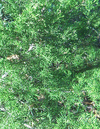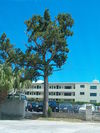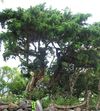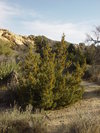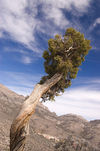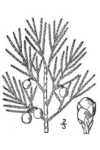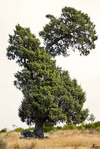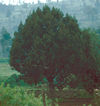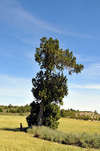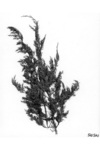Genus Juniperus
Junipers are coniferous plants in the genus Juniperus of the cypress family Cupressaceae.Species in the genus Juniperus of plants
Ashe juniper - The feathery foliage grows in dense sprays, bright green in color. The leaves are scale-like, 2-5 mm long, and produced on rounded shoots. It is a dioecious species, with separate male and female plants. The seed cones are globose to oblong, 3-6 mm long, and soft, pulpy and berry-like, green at first, maturing purple about 8 months after pollination. They contain 1-2 seeds, which are dispersed when birds eat the cones and pass the seeds in their droppings. The male cones are 3-5 mm long, yellow, turning brown after pollen release in December to February.
Bermuda juniper - It is an evergreen tree growing up to 15 m tall with a trunk up to 60 cm thick and thin bark that exfoliates in strips. The foliage is produced in blue-green sprays, with the individual shoots 1.3–1.6 mm wide, four sided in section. The leaves are scale-like 1.5–2.5 mm long and 1-1.5 mm broad, with an inconspicuous gland; they are arranged in opposite decussate pairs, occasionally decussate whorls of three. Juvenile plants bear needle-like leaves 4–8 mm long. The seed cones are irregularly globose to broad pyriform, 4–6 mm long and 5–8 mm broad, soft and berry-like, green at first, maturing bluish-purple about 8 months after pollination; they contain one or two seeds. The male cones are 4–6 mm long, yellow, turning brown after pollen release in early spring.
Juniperus blancoi - It is endemic and found only in Mexico.
Juniperus brevifolia - It is a shrub or small tree growing to a height of 6 m and a trunk diameter up to 50 cm. The leaves are evergreen, needle-like, in whorls of three, glaucous green, 4-10 mm long and 1-3 mm broad, with a double white stomatal band on the inner surface. It is dioecious, with separate male and female plants. The seed cones are berry-like, green ripening in 18 months to orange-red with a variable pink waxy coating; they are spherical, 6-9 mm diameter, and have three or six fused scales in one or two whorls of three, the three larger scales each with a single seed. The seeds are dispersed when birds eat the cones, digesting the fleshy scales and passing the hard seeds in their droppings. The male cones are yellow, 2-3 mm long, and fall soon after shedding their pollen in early spring.
Juniperus californica - It is a shrub or small tree reaching 3 to 8 m , but rarely up to 10 m tall. The shoots are fairly thick compared to most junipers, between 1.5 and 2 millimeters in diameter. The leaves are arranged in opposite decussate pairs or whorls of three; the adult leaves are scale-like, 1 to 5 mm long on lead shoots and 1 to 1.5 mm broad. The juvenile leaves are needle-like, 5 to 10 mm long. The cones are berry-like, 7 to 13 mm in diameter, blue-brown with a whitish waxy bloom, and contain a single seed ; they are mature in about 8–9 months. The male cones are 2 to 4 mm long, and shed their pollen in early spring. It is largely dioecious producing cones of only one sex, but around 2% of plants are monoecious, with both sexes on the same plant. The bark is typically thin and appears to be "shredded".
Canary Islands juniper - It is a large shrub or tree growing to a height of 5-20 m . The leaves are evergreen, needle-like, in whorls of three, green to glaucous-green, 8-23 mm long and 1-2 mm broad, with a double white stomatal band on the inner surface. It is usually dioecious, with separate male and female plants. The seed cones are berry-like, green ripening in 18 months to orange-red with a variable pink waxy coating; they are spherical, 8-15 mm diameter, and have six fused scales in two whorls of three; the three larger scales each with a single seed. The seeds are dispersed when birds eat the cones, digesting the fleshy scales and passing the hard seeds in their droppings. The male cones are yellow, 2-3 mm long, and fall soon after shedding their pollen in February-March.
Chinese juniper - The leaves are of two forms, juvenile needle-like leaves 5-10 mm long, and adult scale-leaves 1.5-3 mm long. Mature trees usually continue to bear some juvenile foliage as well as adult, particularly on shaded shoots low in the crown. It is largely dioecious with separate male and female plants, but some individual plants produce both sexes. The cones are berry-like, 7-12 mm in diameter, blue-black with a whitish waxy bloom, and contain 2-4 seeds; they are mature in about 18 months. The male cones are 2-4 mm long, and shed their pollen in early spring.
Juniperus coahuilensis - The species was known to have been present in North American latitudes defined by the Waterman Mountains of present day Arizona during the Late Wisconsin Glatial Period.
Juniper - Juniperus communis is a shrub or small tree, very variable and often a low spreading shrub, but occasionally reaching 10 m tall. Common Juniper has needle-like leaves in whorls of three; the leaves are green, with a single white stomatal band on the inner surface. It is dioecious, with male and female cones on separate plants, which are wind pollinated.
Alligator juniper - The bark is usually very distinctive, unlike other junipers, hard, dark gray-brown, cracked into small square plates superficially resembling Alligator skin; it is however sometimes like other junipers, with stringy vertical fissuring. The shoots are 1-1.5 mm diameter; the leaves are arranged in opposite decussate pairs or whorls of three; the adult leaves are scale-like, 1-2.5 mm long and 1-1.5 mm broad. The juvenile leaves are needle-like, 5-10 mm long. The cones are berry-like, 7-15 mm in diameter, green maturing orange-brown with a whitish waxy bloom, and contain 2-6 seeds; they are mature in about 18 months. The male cones are 4-6 mm long, and shed their pollen in spring. It is largely dioecious, producing cones of only one sex on each tree, but occasional trees are monoecious.
Syrian juniper - Juniperus drupacea is the tallest species of juniper, forming a conical tree 10-25 m tall, exceptionally up to 40 m, and with a trunk up to 1-2 m thick. It has needle-like leaves in whorls of three; the leaves are green, 5-25 mm long and 2-3 mm broad, with a double white stomatal band on the inner surface. It is usually dioecious, with separate male and female plants.
Juniperus durangensis - It is endemic and found only in Mexico.
Grecian juniper - It is a large shrub or tree reaching 6-20 m tall , with a trunk up to 2 m diameter and a broadly conical to rounded or irregular crown. The leaves are of two forms, juvenile needle-like leaves 8-10 mm long on seedlings, and adult scale-leaves 0.6-3 mm long on older plants. It is largely dioecious with separate male and female plants, but some individual plants produce both sexes. The cones are berry-like, 6-11 mm in diameter, blue-black with a whitish waxy bloom, and contain 3-6 seeds; they are mature in about 18 months. The male cones are 3-4 mm long, and shed their pollen in early spring.
Drooping juniper - The bark is brown, with stringy vertical fissuring. The shoots are strongly pendulous, 1-1.2 mm diameter, and often borne in flattened sprays . The leaves are arranged in opposite decussate pairs; the adult leaves are scale-like, 2-4 mm long and 1-1.5 mm broad. The juvenile leaves are needle-like, 5-10 mm long. The cones are berry-like, 8-20 mm in diameter, green maturing brown, and contain 6-12 seeds ; they are mature in about 18 months. The male cones are 3-5 mm long, and shed their pollen in spring. It is largely dioecious, producing cones of only one sex on each tree.
Juniperus foetidissima - It medium-sized tree reaching 6-25 m tall, with a trunk up to 2.5 m diameter and a broadly conical to rounded or irregular crown. The leaves are of two forms, juvenile needle-like leaves 8-10 mm long on seedlings and re-growth after branch damage, and adult scale-leaves 2-3 mm long on older plants. It is largely dioecious with separate male and female plants, but some individual plants are monoecious, producing both sexes. The cones are berry-like, 7-13 mm in diameter, blue-black with a whitish waxy bloom, and contain 1-2 seeds; they are mature in about 18 months. The male cones are 2-3.5 mm long, and shed their pollen in early spring.
Juniperus formosana - It is found in China and Taiwan.
Juniperus gracilior - Juniperus gracilior is a species of conifer in the Cupressaceae family that is endemic to the Caribbean island of Hispaniola. It is threatened by habitat loss.
Creeping juniper - It lives up to both its scientific and common names, reaching only 10-30 cm tall but often spreading several metres wide. The shoots are slender, 0.7-1.2 mm diameter. The leaves are arranged in opposite decussate pairs, or occasionally in whorls of three; the adult leaves are scale-like, 1-2 mm long and 1-1.5 mm broad. The juvenile leaves are needle-like, 5-10 mm long. The cones are berry-like, globose to bilobed, 5-7 mm in diameter, dark blue with a pale blue-white waxy bloom, and contain two seeds ; they usually have a curved stem and are mature in about 18 months. The male cones are 2-4 mm long, and shed their pollen in early spring. It is dioecious, producing cones of only one sex on each plant.
Juniperus indica - It is of interest as the highest altitude woody plant known, reported growing as high as 5200 m in southern Tibet; the lowest limit being 2600 m.
Oneseed juniper - It is a evergreen coniferous shrub or small tree growing to 2–7 m tall, usually multistemmed, and with a dense, rounded crown. The bark is gray-brown, exfoliating in thin longitudinal strips, exposing bright orange brown underneath. The ultimate shoots are 1.2–1.9 mm thick. The leaves are scale-like, 1–2 mm long and 0.6–1.5 mm broad on small shoots, up to 10 mm long on vigorous shoots; they are arranged in alternating whorls of three or opposite pairs. The juvenile leaves, produced on young seedlings only, are needle-like. The cones are berry-like, with soft resinous flesh, subglobose to ovoid, 5-7 mm long, dark blue with a pale blue-white waxy bloom, and contain a single seed ; they are mature in about 6–8 months from pollination. The male cones are 2-4 mm long, and shed their pollen in late winter. It is usually dioecious, with male and female cones on separate plants, but occasional monoecious plants can be found.
Western juniper - The Juniperus occidentalis shoots are of moderate thickness among junipers, 1-1.6 mm diameter. The leaves are arranged in opposite decussate pairs or whorls of three; the adult leaves are scale-like, 1–2 mm long and 1-1.5 mm broad. The juvenile leaves are needle-like, 5–10 mm long. The cones are berry-like, 5–10 mm in diameter, blue-brown with a whitish waxy bloom, and contain one to three seeds; they are mature in about 18 months. The male cones are 2–4 mm long, and shed their pollen in early spring.
Utah juniper - The shoots are fairly thick compared to most junipers, 1.5-2 mm diameter. The leaves are arranged in opposite decussate pairs or whorls of three; the adult leaves are scale-like, 1-2 mm long and 1-1.5 mm broad. The juvenile leaves are needle-like, 5-10 mm long. The cones are berry-like, 8-13 mm in diameter, blue-brown with a whitish waxy bloom, and contain a single seed ; they are mature in about 18 months. The male cones are 2-4 mm long, and shed their pollen in early spring. It is largely monoecious with both sexes on the same plant, but around 10% of plants are dioecious, producing cones of only one sex.
Prickly juniper - The 'Juniperus oxycedrus tree is very variable in shape, forming a spreading shrub 2–3 m tall to a small erect tree 10–15 m tall. It has needle-like leaves in whorls of three; the leaves are green, 5–20 mm long and 1–2 mm broad, with a double white stomatal band on the inner surface. It is usually dioecious, with separate male and female plants. The seed cones are berry-like, green ripening in 18 months to orange-red with a variable pink waxy coating; they are spherical, 7–12 mm diameter, and have three or six fused scales in 1-2 whorls, three of the scales with a single seed. The seeds are dispersed when birds eat the cones, digesting the fleshy scales and passing the hard seeds in their droppings. The pollen cones are yellow, 2–3 mm long, and fall soon after shedding their pollen in late winter or early spring.
Phoenician juniper - Juniperus phoenicea is a large shrub or small tree reaching 2–12 metres tall, with a trunk up to 1 metre diameter and a rounded or irregular crown. The leaves are of two forms, juvenile needle-like leaves 8-10 mm long on seedlings, and adult scale-leaves 0.5-2 mm long on older plants; they are arranged in opposite decussate pairs or whorls of three. It is largely monoecious, but some individual plants are dioecious. The cones are berry-like, 6-14 mm in diameter, orange-brown, occasionally with a pinkish waxy bloom, and contain 3-8 seeds; they are mature in about 18 months. The male cones are 2-4 mm long, and shed their pollen in early spring.
Juniperus pinchottii - It grows at 600–2,100 m altitude.
African juniper - It medium-sized tree reaching 20-25 m tall, with a trunk up to 1.5-2 m diameter and a broadly conical to rounded or irregular crown. The leaves are of two forms, juvenile needle-like leaves 8-15 mm long on seedlings, and adult scale-leaves 0.5-3 mm long on older plants, arranged in decussate pairs or whorls of three. It is largely dioecious with separate male and female plants, but some individual plants produce both sexes. The cones are berry-like, 4-8 mm in diameter, blue-black with a whitish waxy bloom, and contain 2-5 seeds; they are mature in 12-18 months. The male cones are 3-5 mm long, and shed their pollen in early spring.
Juniperus procumbens - It is a prostrate plant, which usually grows between 20-30 cm tall, although sometimes as high as 50 cm; while it does not get very tall it can get quite wide, 2-4 m across or more, with long prostrate branches. The branches tend to intertwine and form a dense mat. The leaves are arranged in decussate whorls of three; all the leaves are juvenile form, needle-like, 6-8 mm long and 1-1.5 mm broad, with two white stomatal bands on the inner face. It is dioecious with separate male and female plants. The cones are berry-like, globose, 8-9 mm in diameter, dark blackish-brown with a pale blue-white waxy bloom, and contain two or three seeds ; they are mature in about 18 months. The male cones are 3-4 mm long, and shed their pollen in early spring. It is dioecious, producing cones of only one sex on each plant.
Juniperus przewalskii - It is an evergreen tree reaching 15-20 m tall. The leaves are of two forms, juvenile needle-like leaves 4-10 mm long, and adult scale-leaves 1.5-3 mm long on shoots 1.2-1.5 mm thick. Juvenile leaves are found mainly on seedlings but continue to be produced on scattered shoots on mature trees. It is monoecious with male and female cones on the same plant. The seed cones are berry-like, 8-13 mm long and 9–10 mm diameter, blue-black with limited whitish waxy bloom, and contain one, rarely two seeds; they are mature in about 12 months. The male cones are 2-3 mm long, and shed their pollen in autumn.
Juniperus pseudosabina - It is variable in shape, growing as a shrub or small tree, reaching 1-12 m tall. The leaves are of two forms, juvenile needle-like leaves 4-8 mm long, and adult scale-leaves 1.3-2 mm long on shoots 1.5-2 mm thick. Juvenile leaves are found mainly on seedlings but mature plants continue to bear some juvenile leaves as well as adult, particularly on shoots damaged by browsing. It is largely dioecious with separate male and female plants, but some individual plants produce both sexes. The cones are berry-like, 8-14 mm long and 7–10 mm diameter, blue-black with a whitish waxy bloom, and contain a single seed; they are mature in about 18 months. The male cones are 2-3 mm long, and shed their pollen in late winter.
Juniperus recurva - It is a large shrub or tree reaching 6-20 m tall , with a trunk up to 2 m diameter and a broadly conical to rounded or irregular crown. The leaves are needle-like, 5-10 mm long, arranged in six ranks in alternating whorls of three. The cones are berry-like, globose to ovoid, 5-10 mm long and 4-7 mm diameter, glossy blue-black, and contain one seed; they are mature in about 18 months. The male cones are 3-4 mm long, and shed their pollen in early spring. It is largely monoecious with pollen and seed cones produced on the same plants.
Temple Juniper - It is a shrub or small tree growing to a height of 20 to 33 feet and a trunk diameter up to 20 inches . The leaves are evergreen, needle-like, in whorls of three, bright green to yellowish-green, one half to one inch long and .05 inch broad, with a single white stomatal band on the inner surface. It is dioecious, with separate male and female plants. The seed cones are berry-like, green ripening in 18 months to dark purple or brownish with a variable whitish waxy coating; they are spherical, 5-9 mm diameter, and have three fused scales in one whorls of three, each with a single seed . The seeds are dispersed when birds eat the cones, digesting the fleshy scales and passing the hard seeds in their droppings. The pollen cones are yellow, 3-5 mm long, and fall soon after shedding their pollen in spring.
Savin - It is a shrub, very variable in shape, reaching 1–4 m tall. The leaves are of two forms, juvenile needle-like leaves 5–10 mm long, and adult scale-leaves 1–2 mm long on slender shoots 0.8–1 mm thick. Juvenile leaves are found mainly on seedlings but mature shrubs sometimes continue to bear some juvenile leaves as well as adult, particularly on shaded shoots low in the crown. It is largely dioecious with separate male and female plants, but some individual plants produce both sexes. The cones are berry-like, 5–9 mm in diameter, blue-black with a whitish waxy bloom, and contain 1-3 seeds; they are mature in about 18 months. The male cones are 2–4 mm long, and shed their pollen in early spring.
Rocky mountain juniper - It is a small tree reaching 5-15 m tall, with a trunk up to 1 m diameter. The shoots are slender, 0.7-1.2 mm diameter. The leaves are arranged in opposite decussate pairs, or occasionally in whorls of three; the adult leaves are scale-like, 1-2 mm long and 1-1.5 mm broad. The juvenile leaves are needle-like, 5-10 mm long. The seed cones are berry-like, globose to bilobed, 6-9 mm in diameter, dark blue with a pale blue-white waxy bloom, and contain two seeds ; they are mature in about 18 months. The pollen cones are 2-4 mm long, and shed their pollen in early spring. It is dioecious, producing cones of only one sex on each tree.
Russian Juniper - 'Juniperus semiglobosa is an evergreen coniferous shrub or small to medium-sized tree growing to 5–15 metres ) tall, with a trunk up to 1.2 metres ) diameter with flaky bark. The leaves are of two forms, juvenile needle-like leaves 3–7 mm long on seedlings and occasionally on adult plants, and adult scale-leaves 1–2 mm long on older plants; they are arranged in decussate opposite pairs or whorls of three.
Flaky juniper - It is a shrub reaching 2-10 m tall , with flaky brown bark, and a prostrate to irregularly conical crown. The leaves are broad needle-like, 3-9 mm long, arranged in six ranks in alternating whorls of three, and often strongly glaucous blue-green in colour. The cones are berry-like, globose to ovoid, 4-9 mm long and 4-6 mm diameter, glossy black, and contain one seed; they are mature in about 18 months. The male cones are 3-4 mm long, and shed their pollen in early spring. It is largely dioecious, with pollen and seed cones produced on separate plants, but occasionally monoecious.
Juniperus taxifolia - It is an evergreen coniferous shrub growing to a height of 1-3 m . The leaves are needle-like, in whorls of three, light green, 7-14 mm long and 1-1.5 mm broad, with a double white stomatal band on the inner surface. It is dioecious, with separate male and female plants. The seed cones are berry-like, green ripening in 18 months to reddish-brown with a variable light waxy coating; they are spherical, 8-10 mm diameter, and have six or nine fused scales in two or three whorls of three; the three larger scales each with a single seed. The seeds are dispersed when birds eat the cones, digesting the fleshy scales and passing the hard seeds in their droppings. The pollen cones are yellow, 5 mm long.
Juniperus thurifera - It large shrub or tree reaching 6-20 m tall, with a trunk up to 2 m diameter and a broadly conical to rounded or irregular crown. The foliage is strongly aromatic, with a spicy-resinous scent. The leaves are of two forms, juvenile needle-like leaves 8-10 mm long on seedlings and irregularly on adult plants, and adult scale-leaves 0.6-3 mm long on older plants; they are arranged in decussate opposite pairs. It is dioecious with separate male and female plants. The cones are berry-like, 7-12 mm in diameter, blue-black with a whitish waxy bloom, and contain 1-4 seeds; they are mature in about 18 months. The male cones are 3-4 mm long, and shed their pollen in early spring.
Juniperus tibetica - It is an evergreen coniferous shrub or small to medium-sized tree growing to 5–15 m tall, with a trunk up to 2 m diameter. The leaves are of two forms, juvenile needle-like leaves 5 mm long on seedlings and occasionally on adult plants, and adult scale-leaves 1.5–3 mm long on older plants; they are arranged in decussate opposite pairs or whorls of three. The cones are ovoid, berry-like, 9–16 mm long and 7–13 mm diameter, blue-black, and contain a single seed; they are mature in about 18 months. The male cones are 1.5–2 mm long, and shed their pollen in spring. It is usually monoecious , but occasionally dioecious .
American Juniper - The Lakota Native American name is Chansha, "redwood" or Hante'. In its native range, it is commonly called "cedar" or "red cedar," names rejected by the American Joint Committee on Horticultural Nomenclature as it is a juniper, not a true cedar. However, "Red Cedar" is by far the most commonly used name.

